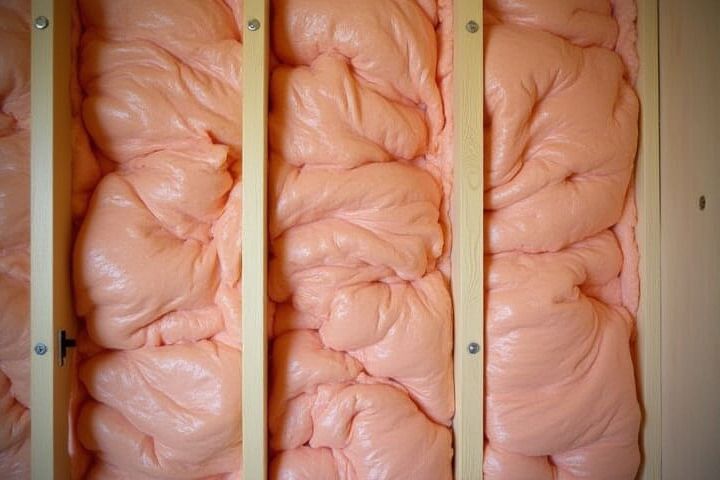
The best house insulation options include fiberglass batts, foam board, spray foam, and cellulose. Fiberglass batts are popular for their affordability and ease of installation, while foam board offers excellent thermal resistance with minimal space usage. Spray foam insulation expands to fill gaps, providing an airtight seal that helps prevent heat loss. Cellulose, made from recycled paper, is an environmentally friendly choice that also offers soundproofing benefits. When selecting insulation for your home, consider factors such as R-value, moisture resistance, and installation method to ensure optimal energy efficiency.
What Is The Best House Insulation
R-Value
When considering house insulation, focus on materials with a high R-Value, which measures thermal resistance. Spray foam insulation offers an R-Value ranging from 6.2 to 7.0 per inch, making it one of the most efficient options for preventing heat transfer. Fiberglass batts, commonly used in residential homes, provide an R-Value between 2.9 to 4.3 per inch, suitable for moderate climates. For optimal energy efficiency, aim for a total R-Value of 30-60 based on your region's climate zone, ensuring that your home remains comfortable year-round.
Material types
Fiberglass insulation, recognized for its affordability and thermal performance, consists of tiny glass fibers that trap air, achieving an R-value of 2.9 to 4.3 per inch. Spray foam insulation offers superior air sealing and can attain an R-value between 5.0 and 7.0 per inch, making it ideal for irregular spaces. Cellulose insulation, made from recycled paper products, provides a sustainable option with an R-value of approximately 3.2 to 3.8 per inch while also reducing air leakage. Mineral wool, or rock wool, enhances fire resistance and has an R-value of 3.0 to 3.3 per inch, making it suitable for areas requiring additional safety.
Climate suitability
When considering climate suitability for house insulation, rigid foam board insulation excels in areas with extreme temperatures, providing excellent thermal resistance. In colder climates, fiberglass batts are popular due to their effectiveness at maintaining warmth, while spray foam insulation offers unparalleled air sealing and moisture resistance. For milder temperatures, cellulose insulation made from recycled materials promotes sustainability and energy efficiency, helping to regulate indoor temperatures. Always assess local weather patterns and energy needs to select the best insulation option tailored to your geographic location.
Energy efficiency
Spray foam insulation is considered one of the best options for energy efficiency, providing an excellent air seal that minimizes heat transfer. This type of insulation expands upon application, filling gaps and cracks, which significantly reduces energy costs by preventing air leaks. For a more environmentally friendly choice, cellulose insulation made from recycled paper offers good thermal performance and is treated to be fire-resistant. To further enhance energy efficiency, consider using insulated concrete forms (ICFs), which provide superior insulation and thermal mass benefits, ensuring consistent indoor temperatures year-round.
Environmental impact
Foam board insulation is known for its excellent thermal resistance and reduced environmental impact, making it a popular choice among eco-conscious homeowners. This type of insulation is often made from polystyrene or polyisocyanurate, offering superior R-values and durability while minimizing energy consumption in buildings. Additionally, cellulose insulation, derived from recycled paper products, is an environmentally friendly option that effectively reduces drafts and conserves energy. By choosing sustainable insulation materials, you contribute to energy efficiency and lower carbon footprints, enhancing your home's environmental performance.
Installation method
Foam board insulation is highly regarded for its ease of installation and efficiency in reducing heat transfer. This rigid material is typically cut to fit snugly between studs, joists, or other structural cavities, allowing for a seamless fit that minimizes air leakage. Spray foam insulation, on the other hand, expands upon application, filling gaps and providing an air barrier, making it ideal for irregularly shaped spaces. When considering insulation options, both foam board and spray foam offer effective thermal resistance while simplifying the installation process.
Durability
Foam board insulation stands out for durability, providing excellent thermal resistance with minimal moisture absorption. Closed-cell spray foam insulation offers robustness, expanding to fill gaps, thereby enhancing air sealing and reducing the risk of mold growth. Additionally, fiberglass batts are popular for their long lifespan, though their effectiveness can diminish if compressed or exposed to water. For long-term performance, cellulose insulation, treated for fire resistance, can last while being environmentally friendly, making it an excellent choice for sustainable building practices.
Fire resistance
Mineral wool, also known as rock wool, offers superior fire resistance, withstanding temperatures up to 1,000 degrees Fahrenheit. This material is non-combustible and can help slow the spread of flames, providing valuable time for evacuation. Closed-cell spray foam insulation also exhibits fire resistance with a Class A fire rating, making it suitable for various applications. For optimal fire safety, consider installing a minimum of R-30 insulation in your attic to improve thermal performance while enhancing fire resistance.
Moisture control
Spray foam insulation is highly effective for moisture control, expanding to fill gaps and creating an airtight seal that prevents water vapor ingress. Closed-cell spray foam offers both superior thermal resistance and a moisture barrier, making it ideal for basements and crawl spaces. Fiberglass insulation, when properly installed with vapor barriers, can also provide adequate moisture control while promoting breathability in your home. Choosing an insulation material with a high R-value will enhance energy efficiency while mitigating the risks associated with mold and dampness.
Cost-effectiveness
Fiberglass insulation remains a cost-effective choice for homeowners, typically costing between $0.40 and $1.50 per square foot. It boasts an R-value of 2.2 to 4.3 per inch of thickness, making it highly efficient for thermal resistance. You can save about 20% to 30% on your heating and cooling costs by properly insulating your home. Spray foam insulation, while pricier at $1.00 to $3.00 per square foot, offers superior air sealing and higher R-values, ranging from 5.0 to 6.5 per inch, which may lead to greater long-term savings despite the initial investment.
